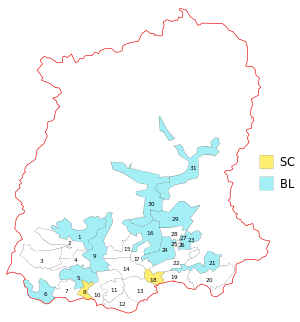Sikkim Legislative Assembly
The Sikkim Legislative Assembly is the unicameral state legislature of Sikkim state in north-eastern India. The seat of the Legislative Assembly is at Gangtok, the capital of the Sikkim state.
Sikkim Legislative Assembly | |
|---|---|
| 10th Legislative Assembly of Sikkim | |
 | |
| Type | |
| Type | |
Term limits | 5 years |
| Leadership | |
Speaker | |
Deputy Speaker | |
Leader of the House (Chief Minister) | |
| Structure | |
| Seats | 32 |
 | |
Political groups | Government (31)
Others (1)
|
| Elections | |
| First past the post | |
Last election | 11 April 2019 |
| Meeting place | |
 | |
| Sikkim Legislative Assembly, Gangtok, Sikkim, India | |
| Website | |
| Sikkim Legislative Assembly | |
History
Sikkim became the 22nd State of India Vide Constitution(36th Amendment) Act 1975. The Act provides that the Legislative Assembly of Sikkim shall consist of not less than thirty two members and that "the Assembly of Sikkim formed as a result of the elections held in Sikkim in April 1974 with 32 members elected in the said elections (hereinafter referred to as the sitting members) shall be deemed to bsthe legislative Assembly of the State of Sikkim duly constituted under the Constitution."
Sikkim is situated in the North East of the union and has a geographical area of 7096 km only having a population of 6.7 lakhs and 40 thousand. It was a tiny Himalayan kingdom once ruled by the hereditary monarchy for about 3 centuries from 17 century A.D. In 1950, the kingdom became a protectorate of the Government of India vested with autonomy in its internal affairs while its defense, communications and external relation under the responsibility of the protector. The kingdom finally opted to become full-fledged State of the Indian Union with effect from 26 April 1975 vide the Constitution 36th Amendment Act 1975 with special provision laid for the State under article 371(F) of the Constitution of India.
Kazi Lhendup Dorjee was the First Chief Minister of Democratic Sikkim state from 1975 to 1979. The 1979 assembly election saw Nar Bahadur Bhandari elected Chief Minister of Sikkim. Nar Bahadur Bhandhari held on to win again in 1984 and 1989. In 1994, Assembly politician Pawan Kumar Chamling became the Chief Minister of Sikkim. In 1999, 2004, 2009,2014-2019 made him the longest-serving Chief Minister in the Country. 2019 Election result not declared.
- B B Gurung became Chief Minister of Sikkim for 13 days in Sikkim from 11 May 1984 to 25 May 1984.
- Sanchaman Limboo became Chief Minister of Sikkim for 179 days from 17 June 1994 to 12 December 1994.
Structure

There are 32 members in a legislative assembly. There are 2 seats reserved for scheduled castes (SC), 12 for scheduled tribes (ST) out of 32 seats. These scheduled tribes include ethnic tribes such as Bhutia, Lepcha (Sherpa), Limbu, Tamang and other Sikkimese Nepali Communities as specified during the merger of the Kingdom of Sikkim (monarchy) into India making it the 22nd state of the Indian republic in 1975, setting up a democracy within the state. One Sangha seat is reserved for 2900 monks of over 100 monasteries.[1][2]
Constituencies and Members
The tenth assembly was elected in 2019 Sikkim Legislative Assembly election. The current members are listed below:[3]
See also
- List of states of India by type of legislature
- Vidhan Sabha
References
- Sikkim Legislative Assembly
- "Sikkim Assembly polls LIVE: Pawan Chamling's fate hangs in balance as voting begins". Zee news. 12 April 2014. Retrieved 11 May 2014.
- "Sikkim Result Status". ECI. p. 1 to 4. Archived from the original on 16 May 2014.